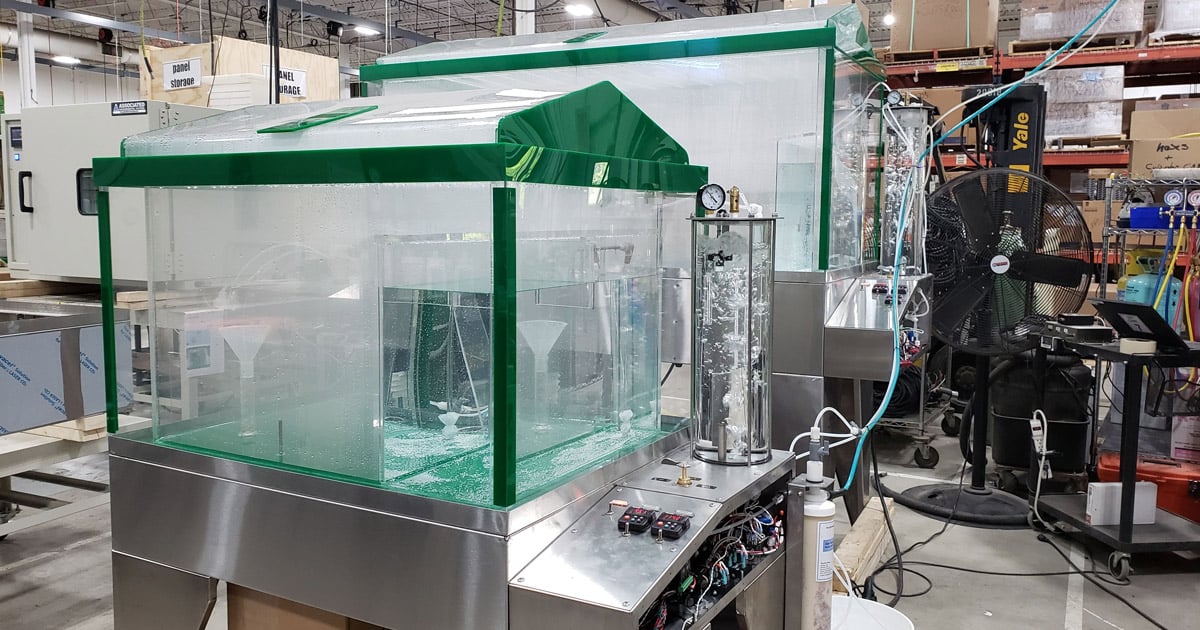Salt spray testing is an important part of environmental testing and has many applications across industries. It involves the use of saltwater solutions to simulate various conditions including salt mist, fog, dew, and rain. Salt spray tests are used to determine the corrosion resistance or rust prevention capabilities of materials and assemblies subjected to a wide variety of atmospheric conditions.
This type of testing can also be applied in areas such as paint adhesion, electrical insulation properties, seal integrity, and other material properties that may be affected by moisture or humidity. By simulating these real-world situations in a controlled laboratory environment through salt spray tests, manufacturers can ensure their products are durable enough for long-term use under harsh weather conditions.
Overview of Salt Spray Testing
Salt spray testing is a key component of environmental testing, enabling organizations to assess the effects of salt-rich environments on materials and components. This type of testing helps ensure that products are designed to withstand harsh climatic conditions such as salty air or seawater exposure. It involves subjecting materials and objects to repeated cycles of salt solution spraying to monitor their performance over time.
The test results can be used for comparative purposes, allowing manufacturers and designers to identify which material performs best under different types of salt spray exposures. Salt spray tests can also provide valuable information about corrosion resistance, adhesion strength, paint durability, sealant effectiveness, and other important characteristics related to product design and reliability. As such, it plays an essential role in helping companies produce safe and reliable products for consumers across the globe.
Benefits of Salt Spray Testing

Salt spray testing is an essential part of environmental testing that can provide many benefits. The main benefit is the ability to detect and measure corrosion due to salt exposure in a variety of materials. This helps ensure that products remain safe and perform as expected when exposed to salt water or salty air for extended periods.
Additionally, it provides valuable insight into how products will react in different climates, allowing manufacturers to make informed decisions about which materials are best suited for their particular application. Salt spray testing also allows companies to identify any potential weaknesses or flaws in the manufacturing process before they become costly problems down the line. Finally, it serves as an effective quality control tool by providing a comprehensive view of product durability over time, ensuring safety and reliability throughout its lifespan.
Applications and Uses for Salt Spray Testing
Salt spray testing is a widely used method of environmental testing that can help determine the durability and longevity of materials in a range of different industries. It is used to simulate salt-laden atmospheres, such as coastal areas, which are prone to corrosion and degradation due to their high levels of salt content. Salt spray testing can be applied in many different ways across various sectors including automotive, construction, marine industry, medical device manufacturing, and consumer products. In the automotive industry, it is essential for components exposed to harsh weather conditions or road salts to pass rigorous tests before they are allowed on the market. This could include things like door handles and hinges which need to withstand long periods of being exposed outdoors without corroding or rusting.
The same applies when it comes to other vehicles too; aircraft require salt spray tests for parts like landing gear doors as these are also prone to regular exposure from sea salts during takeoff and landings near coastal areas. In terms of construction materials performance needs must meet certain standards laid down by regulatory bodies so that buildings remain structurally sound for longer periods even when faced with extreme weather conditions such as rain storms or snowfall mixed with salty air from nearby coastlines. Metal-coated steel alloys have become increasingly popular over recent years due to their ability to withstand corrosive environments but even then they still require regular maintenance checks using salt spray tests where required.
The marine industry has been historically reliant on salt spray testing thanks to its reliance on outdoor elements whether at sea or docked up close coastal townships large ships often get battered by rough seas making them more susceptible to wear and tear damage over time unless adequate protective measures have been taken prior hand this why most shipyards use extensive amounts test before launch date ensure the vessel remains seaworthy throughout its life span. Finally, Consumer product manufacturers regularly conduct pre-release assessments of products containing metal components to make sure will stand test time if placed outside constantly wet environments.
Challenges with Salt Spray Testing

Salt spray testing is one of the most important aspects of environmental testing. However, this form of testing can prove to be challenging for both testers and manufacturers alike. For starters, salt spray tests require a high level of accuracy to guarantee reliable results. Not only must the test specifications be adhered to precisely, but also any potential external factors that may affect the salt spray’s effect on a product must be taken into consideration as well.
Furthermore, given the corrosive nature of salt sprays, they can potentially cause irreparable damage if misused or applied incorrectly. As such, all safety protocols must be followed when conducting such tests to minimize these risks and ensure accurate outcomes. Moreover, since these tests involve subjecting products to extreme conditions for extended periods of time there is always a possibility for unexpected wear or failure due to long-term exposure which could lead to inaccurate test results and unreliable data analysis overall.
Conclusion
Salt spray testing is an essential part of environmental testing, as it can provide valuable insights into the performance of a material or product in extreme environments. It helps manufacturers to understand how materials will react when exposed to salt water and other corrosive elements, which can be used to improve the durability and reliability of their products.
Salt spray testing is simple, cost-effective, and easy to interpret the results; making it an ideal method for evaluating the corrosion resistance of materials used in industrial applications. By performing this test regularly, companies can ensure that their products are safe and reliable even when exposed to harsh conditions.